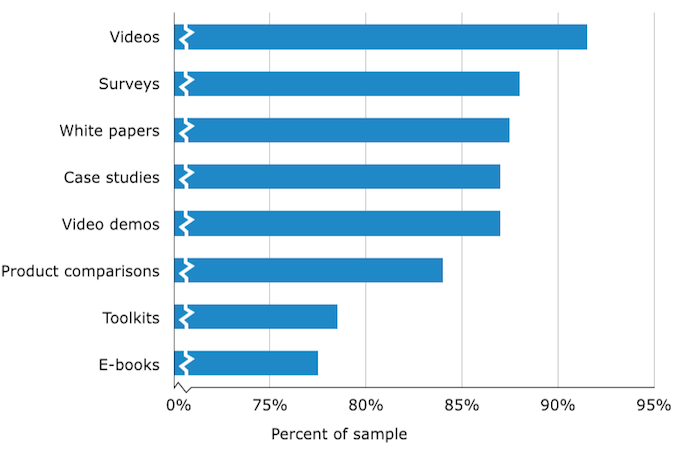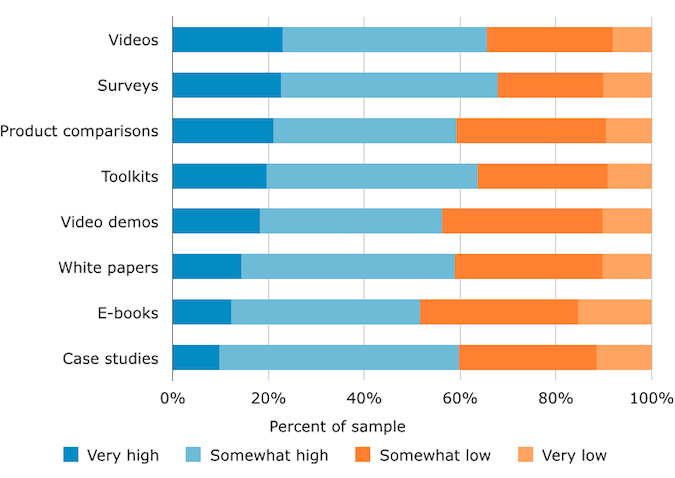Diving into video marketing can be a real challenge for many organizations. Inexpensive video production can make your brand look amateurish, but professional production can be extremely expensive. However, many marketers are overcoming the hurdles as they discover that video can do more than build buzz and gain YouTube followers. That’s because for today’s B2B marketers, video has become a must-have demand generation tool.
In fact, according to the results of a recent survey from marketing technology reviewer Software Advice, if you’re not using video, you may be missing out on a valuable way to get more leads. In their annual B2B Demand Generation Benchmark report, they surveyed 200 B2B marketing professionals in order to understand which channels, offers, content types, and technologies are driving results for their demand generation programs. Here’s what they found out about video marketing.
Moving Images
In the survey, respondents were asked to rank the demand- and lead-generation effectiveness of various types of content, offers and calls-to-action (CTAs). Video is being used by a whopping 92% of B2B marketers for demand generation programs. That’s above surveys (88%), white papers (88%) and case studies (87%).
These results may seem surprising. Video, as I mentioned before, can be difficult to produce for many organizations. The answer might be in the demographics. According to Software Advice, respondents primarily hailed from larger businesses, with 73% working at organizations with 100 employees or more. And 13% of respondents represented businesses with over 10,000 employees.
For obvious reasons, developing video is a lot easier for marketers working for large companies. Some have in-house video teams, and many work with creative agencies that offer video as part of their service portfolio. But still, marketers from smaller teams can get into the act. Even basic “talking head” type videos can get results, as long as the content has a great value proposition or tips from a trusted expert (and isn’t boring). Those factors matter more than a big budget or special effects.
Videos that Drive Leads
As we all know, videos have been growing in popularity online, to put it mildly. And while many of us are just watching more movies of cats who can’t jump, some people are actually watching demonstrations of enterprise-level software solutions. According to the Software Advice survey, video is quickly proving itself to be an excellent way to reach new business prospects and turn them into leads.
When asked to evaluate content types, marketers most commonly cited B2B videos as generating a “very high” quantity of leads (23%). Videos are apparently more than just indirect interest generators (and entertainers). They’re actually responsible for directly producing leads and driving conversions.
Clearly, B2B marketers seeking a competitive advantage would do well to consistently use video content to attract new visitors and turn them into leads. Want to learn more about what the future holds for marketers? Read the Software Advice B2B Demand Generation Benchmark survey report to see additional predictions for demand generation strategy and spending in 2015.
Getting Started Behind the Camera
But what if you’ve never created a video – not even for your kid’s birthday party? It’s not difficult to get started, but there are some key tips to keep in mind. First of all, you need to determine why you’re making the video (other than the fact that everyone else is doing it). Then you need to determine which kind of video you’re making, and how long it should be. (Tip: shorter is better.)
In webinar from earlier this year, “Content Marketing: Is 2014 Really Shaping up to be the Year of Video?” we heard best practices for video marketing from Richard Boehmcke of Vibrant Motion, Kristen Craft of Wistia, and Zach Cole of Lyft . Here are a few of their tips for the common types of videos, as well as some ideas for using them to drive leads.
- Educational. The goal of educational videos is to help viewers figure out how to solve a problem or improve a situation. Because they often go into some depth, these videos can run from 5 to 15 minutes. To generate leads from these videos, you could create a series, where the first one is available to everyone, but in order to see the whole series, viewers would need to provide contact information. Let people subscribe to email alerts that tell them when the next installment in the series is available.
- Product demos. If you’re showing a brand-new or complex product, your video will likely be long – up to 15 or 20 minutes. If your prospects are already familiar with your product category, you can probably deliver your message in less than a minute. What’s new? What’s compelling? Focus on what’s in it for prospects and customers. These types of videos can be a great way to upsell current customers by getting them to buy add-on features and upgraded services.
- Asking for help. If you’re working for a non-profit, fundraising videos are a must-have. But for-profit organizations can use these as well. For example, a shipping company could create a video of drivers dressed as elves, delivering holiday gifts to a local charity. The call to action might be to get people to sign up to join the company in a toy drive. This kind of video can be entertaining as well as compelling, and might run anywhere from five to 10 minutes.
- Case studies. Real-world case studies are a natural topic for video. They make it possible for companies to let their customers do the talking about features and capabilities, which is why customer interviews are key. These can run anywhere from three to seven minutes.
Be sure to watch “Content Marketing: Is 2014 Really Shaping up to be the Year of Video?” to get even more video marketing success strategies. And remember, you don’t have to produce a video that goes viral in order to be successful (unless you’re in the cat video business). But you do need to make sure you make every minute count by making your message well worth the time for your customers and prospects.


